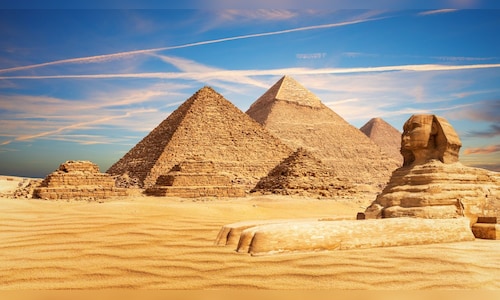Thanks to a $30 million renovation that reimagines the experience, visiting the pyramids is now more about wonder than frustration. A fleet of buses transports visitors around the site, aggressive sales tactics have been curtailed, and there’s even an opportunity to enjoy fine dining while overlooking the 4,600-year-old structures.
This official launch is set for July 3 – a significant milestone achieved after seven years of effort. In 2018, the Egyptian government entered a public-private partnership with Egyptian billionaire Naguib Sawiris’ Orascom Pyramids Entertainment to revamp the Giza Plateau, where the ancient monuments are located.
Also read | Visa-free travel for Indian passport holders to the Philippines begins from this date
A soft launch commenced in early April, enabling OPE to make necessary improvements and rectify issues ahead of a broader unveiling, as stated by OPE Executive Chairman Amr Gazarin in an interview. The firm will manage the site for the next 11 years, generating revenue not from ticket sales — which remain solely under government control — but from exclusive tours, sponsorship arrangements, and commercial leases on the grounds.
The opening coincides with the eagerly anticipated inauguration of the Grand Egyptian Museum — the $1 billion flagship attraction located approximately a mile away. Together, these two projects signify significant progress toward Egypt’s goal of doubling annual visitors to 30 million within the next decade, putting it on par with Greece and making it one of the most-visited countries globally.
New gate, new rules
One major change involved making the Giza Plateau car-free. Instead of driving along a winding road in the shadow of the Great Pyramid, visitors now enter through a gate located on a highway 1.5 miles to the southwest.
Also read | Parties restart in Lebanon as it looks to attract wealthy Gulf tourists to boost war-torn economy
After passing through the so-called Great Gate and purchasing tickets, visitors enter a modern hall filled with introductory exhibits before boarding new hop-on, hop-off buses. Within minutes, they can disembark at the base of the three massive pyramids, each constructed from 80-ton limestone blocks. The iconic Great Sphinx is located a bit further away.
At bus stops throughout the site, visitors will find amenities that were previously missing, including updated restrooms, formal souvenir shops, and cafes. With several dining options opening recently, it’s now possible to enjoy a meal on-site.
Khufu’s, which offers an upscale take on Egyptian classics and features a terrace overlooking the pyramid dedicated to the pharaoh of the same name, has been recognized as one of the finest restaurants in the Middle East and North Africa by World’s 50 Best.
“It wasn’t a good experience before, for sure,” stated Mariam Al-Gohary, a 37-year-old Egyptian-Canadian who visited the pyramids for the first time in 15 years in mid-May.
“Now it feels like a visit to a museum,” Al-Gohary remarked, who works in human resources in Calgary, Alberta. “It resembles what you would expect from a major tourist destination.”
Visitor numbers increased by almost 24% in April compared to the previous year, according to the Tourism Ministry. Egypt’s tourism sector is currently booming and saw record arrivals in the early months of 2025, making it unclear how much impact this project specifically had on the surge.
Tackling horsemen
Gazarin notes that Egyptian authorities are assisting OPE in addressing a significant issue: hawkers offering horse and camel rides, who have often been criticized for being aggressive and overcharging tourists.
Al-Gohary from Calgary recollected that when she and her friend rode camels in 2010, the owner demanded extra payment to have the camels kneel for them to dismount — a notorious tactic. This year, she completely avoided them.
For newcomers, it’s now simpler to steer clear of potential scams. The new arrangement has restricted horsemen and sellers from accessing the previous entrance, where they were known to harass tourists. Authorities have designated a more isolated area for the horsemen, though many remain defiant in their attempts to move closer to the pyramids.
Gazarin acknowledges that it’s a work in progress, with expectations that authorities will gradually impose stricter restrictions to enhance enforcement.
“People were hesitant to visit the pyramids” because of this issue, he stated.
He laments that the pyramids attract only 2.5 million visitors per year, with half being Egyptians. In comparison, over 12 million people visited the Colosseum in Rome in 2023.
However, Gazarin understands that building those numbers will take time, especially amid regional conflicts that create a degree of unpredictability. What matters, he believes, is that visitor numbers continue to grow.
“It’s unacceptable that the world’s most important monument only draws just over one million foreign tourists.”



